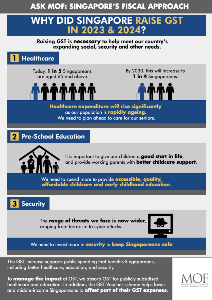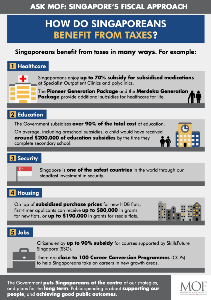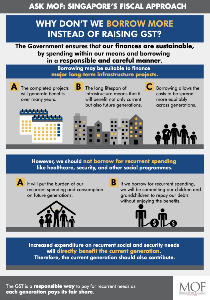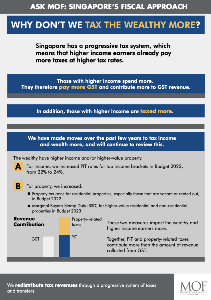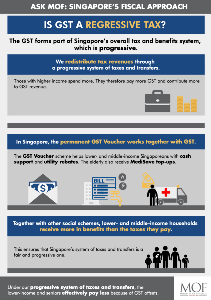What is GST?
Goods and Services Tax (GST) is a broad-based tax on domestic consumption.
It is collected by GST-registered businesses that act as collection agents on behalf of the Government.
What does GST apply to?
GST is levied on:
a) goods and services procured in Singapore from GST-registered persons; and
b) goods and services imported into Singapore.
What goods are exempt from GST?
GST is not levied on non-taxable goods and services. This includes goods and services that are exempt from GST or are out-of-scope of GST.
- Exempt – The sale and lease of residential properties, provision of financial services, import and local supply of investment precious metals, and supply of digital payment tokens (from 1 January 2020) are exempted from GST.
- Out-of-scope – Out-of-scope supplies include the sale of goods that are not brought into Singapore and sales of overseas goods made within the Free Trade Zone and Zero GST Warehouses.
Please refer to IRAS' website to learn more about the GST registration process and matters pertaining to the GST registration.
Why don't we exempt basic necessities from GST?
This may sound attractive, but there are two problems:
- Exempting basic necessities is an ineffective redistributive tool, as it does not effectively target support to those with greater needs. It benefits the well-to-do more, because they spend more on everything, including basic necessities.
- A multi-tiered GST system leads to highly arbitrary distinctions between products, and creative efforts by businesses to get their products classified in lower tiers. Examples of disputes in other jurisdictions with multi-tier systems include whether mozzarella pizza toppings should be classified as “cheese” (and charged at a lower GST rate) depending on its vegetable oil content. This makes the system onerous to implement, unnecessarily complicating our GST system and increasing businesses’ compliance costs, which may eventually be passed on to consumers.
We have instead designed a fairer and more effective GST system, tiered by income, such that lower-income households pay a much lower effective GST rate than higher-income households. This is achieved through the permanent GST Voucher Scheme, and GST absorption on publicly subsidised education and healthcare.
Why did we need to raise GST from 7% to 8% in 2023, and from 8% to 9% in 2024?
Our population is ageing rapidly. By 2030, around 1 in 4 Singaporeans will be aged 65 or above, up from 1 in 6 in 2024. We will need to spend more on healthcare to support our seniors. These are our grandparents and parents.
It is important to give our children a good start in life, and provide working parents with better childcare support. We need to spend more to provide accessible, quality, affordable childcare and early childhood education.
The range of threats we face is also wider, ranging from terrorism to cyber-attacks. We need to invest more in security to keep Singaporeans safe.
Thus, more Government revenue is required to support higher spending. Raising GST was the prudent and sustainable way to achieve this.
The needs are recurrent and therefore require a recurrent source of revenue.
The increased expenditure will benefit all; it is therefore fair for all to contribute.
How will the Government help to manage increases in cost of living?
The Government will continue to support Singaporeans through subsidies on education, health, housing, and other assistance, and absorb GST on publicly-subsidised education and healthcare.
To address the 2%-pt increase in GST (1%-pt in 2023 and 2024 respectively), the Government rolled out the Assurance Package (AP) to ensure that majority of the households will not feel the impact of the additional GST for at least 5 years. This cushions the impact of the GST increase on top of the permanent GST Voucher scheme which targets support for the lower- and middle-income groups.
The impact of the GST increase on inflation was transitory. CPI inflation was 6.1% in 2022, prior to the 2%-pt increase in GST. It moderated to 4.8% in 2023, and further to 2.4% in 2024. Nonetheless, the Government recognises that prices have increased primarily due to the impact of global factors such as geo-political changes and supply chain disruptions, and Singaporeans are still adjusting to these new price realities.
The Government provided additional cost-of-living support to cushion the impact of inflation including the GST rate increase, through several enhancements to the AP over 2022 to 2025. The support includes additional cash payments, U-Save, S&CC Rebate, and CDC Vouchers.
In the long run, the most effective way to help Singaporeans cope with inflation is to improve productivity and grow real wages over time. The Government strives to achieve this by growing the economy, creating good jobs and supporting Singaporeans to take on these jobs through continued education and training.
For more information on the support you are eligible for, you may check out the Support for You Calculator.
Keen to find out more? Check out the resources below.
About GST
When was GST introduced in Singapore?
GST was introduced in Singapore on 1 April 1994.
What was Singapore’s GST rate over the years?
When GST was introduced in 1994, the rate was 3%. This was
increased to 4% in 2003, 5% in 2004, 7% on 1 July 2007, 8% in 2023 and 9% in 2024.
Infographics
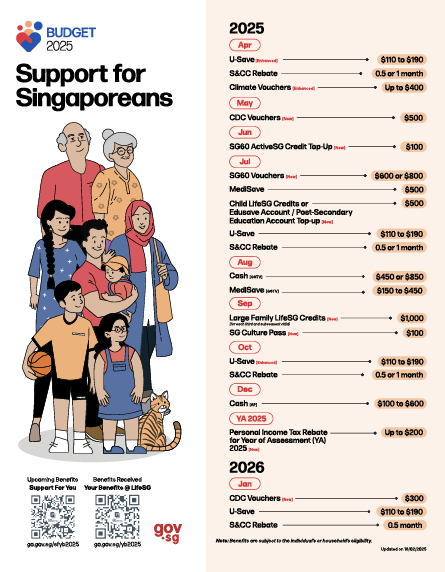
Assurance for 2025
Support for Singaporeans
For more information upcoming benefits, visit go.gov.sg/sfyb2025
To find out how much benefits you have received, visit go.gov.sg/yb2025

